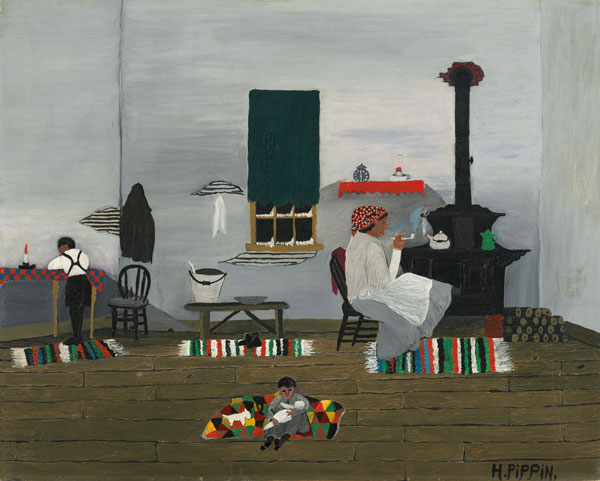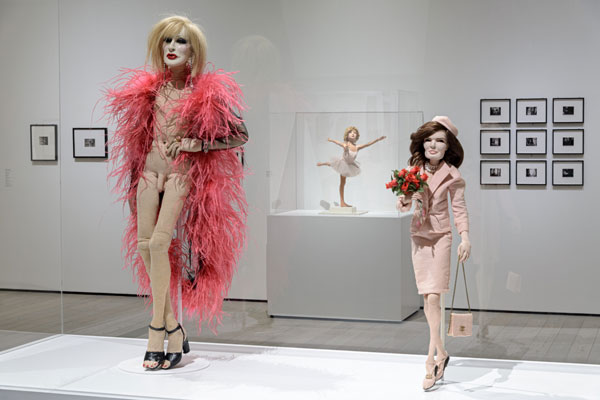Outsider artists, or untrained artists, have been variously labeled Primitive, Naïve, Visionary and Self-Taught. One of the things I like most about such artists is their distinct and fully-imagined worldview, a consciousness that exists without being overly precious or self-conscious. After all, they did not produce art with a market or a collector in mind; they did so to please themselves or, sometimes, the inner voice which they believed to be a higher power. “Outliers and American Vanguard Art,” an exhibition at LACMA through March 17, isn’t just about Outsider artists, of course—it’s about the dialogue between the work they produced and some of the trained, professional artists of the 20th and early 21st centuries who might have been inspired or influenced by them.
“At many points in the past century, vanguard artists (a term used here to encompass the various avant-gardes throughout this period) found affinities and inspiration in the work of their untutored, marginalized peers,” the introductory wall text tells us. However, I’m not sure the connection is well articulated through these 250 works by 80 artists. They are shown side by side, with no demarcation. This was a deliberate decision, as curator Lynne Cooke explained in a press walk-through before the show opened. (“Outliers” originated at the National Gallery of Art in Washington, D.C., where Cooke is Senior Curator.) Still, you can often tell who the Outsiders are by looking at the work—rough brushstrokes or composition, strange and multiple perspectives, for example—and sometimes by reading the wall text. Indeed, here’s one show where I would have preferred a little more text to draw out specific parallels or articulated influences.
“Outliers” is the term adopted here, as explained in the introductory text, because it “cuts across orthodox ways of thinking in favor of more diverse and inclusive representation.” I suspect it’s also because it’s trendier. Personally, I’ve long had a deep interest in Outsider Art and, whatever the terminology, believed it deserved rightful place in art museums. When I lived in Washington, D.C., one of my favorite pieces of art—one I went to view and admire again and again—was James Hampton’s epic “Throne of the Third Heaven of the Nations’ Millennium General Assembly” at the Smithsonian American Art Museum: a revelation created out of humble aluminum wrap, cardboard and light bulbs. (It is included in the “Outliers” exhibition as part of a slide show.) I recognized a number of Outsider artists included in the “Outliers” exhibition—the usual suspects like Henry Darger, Howard Finster, Séraphine Louis, and Martín Ramírez are here—and was happy to be introduced to many that I was unfamiliar with.

Horace Pippin, Interior, 1944, oil on canvas, National Gallery of Art, Washington.
The show is arranged roughly chronologically, from when “insiders” (my term) who worked at museums such as the Whitney Studio Club (now the Whitney Museum of American Art) and the Museum of Modern Art began bringing Outsider Art into the fold in the 1920s and ’30s. The main wall text places a lot of emphasis on that curatorial history.
For me the pleasure of this show lies mainly in the work of the Outsiders, because they worked from their core and called upon native talents to express what was often urgent and ineffable, and they did it well. They are in this show because somewhere, somehow, someone on the inside—an art dealer, a curator, another artist—recognized the artistry of their output. Perhaps emblematic of the Outsider artist is Bill Traylor. Last fall I was fortunate enough to be in D.C. when the major retrospective of his work, “Between Worlds: The Art of Bill Traylor,” was at the Smithsonian American Art Museum. Traylor’s life spanned landmark changes in race relations in the United States. Born into slavery in Alabama in 1853, he lived through the Civil War, Reconstruction and the ultra-segregated Jim Crow era. In his mid-70s he left his rural milieu and made his way to Montgomery, where he settled in the black section of town. There, in a four-year period, he produced most of the 1200 works on paper left behind when he died in 1949. Traylor used pencil, colored pencil and poster paint on the scrap paper and cardboard that was readily available. He created a vivid vocabulary of stylized figures to describe his experience of being a Black man in the American South. The main figure is often a man with a tall hat, seen in profile. He’s sometimes pointing, sometimes holding something—a pipe, a rifle or a bottle. Snarling dogs may appear, or leaping rabbits, or birds.
It has always struck me how often Outsider artists saw art-making as a religious calling. One of the Outsiders in the exhibition, Sister Gertrude Morgan, once said, “My heavenly father called me in 1934 …” She became a street missionary in New Orleans, and in 1966 she said that God told her to draw pictures of the world to come, the New Jerusalem. Like Traylor, she used what was available—cardboard, blocks of wood, jelly jars, Styrofoam and plastic. Unlike Traylor, she liked to fill the surface with multiple figures, color, and sometimes text, as she did in Revelation 7 (1970).
While the dialogue between Outsider and insider art is not well articulated throughout this exhibition, I do think they are connected, particularly through the original inspirations and impulses towards representation. One clear connection is Jim Nutt, whose figures are cartoonishly surreal and rely heavily on line work, like Outsider Art but far more polished. He also collects Outsider Art, and, along with his dealer Phyllis Kind, he acquired the bulk of the works left behind by Martin Ramirez. (Kind later brought Ramírez’ work to market.)
I did enjoy seeing some of the Insider work here, including assemblage by Betye Saar and prints by Kara Walker. Both have some of the qualities I admire in Outsider Art—directness and sincerity and references to past traditions. Fortunately, sincerity does not preclude irony, which both artists conjure to great effect. In Walker’s 2005 prints, she sets silhouettes of slaves against the backdrop of vintage illustrations from Harper’s Pictorial History of the Civil War from 1866, showing the brutal hard work and abuse they were subject to against the highly romanticized landscape that the North and South were supposedly fighting for. Even in her recent works, Walker maintains the sense of urgency, anger and marginality of the outsider, which is what keeps her work relevant and so very powerful.


